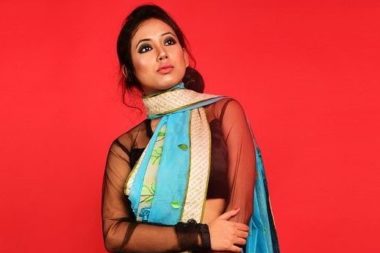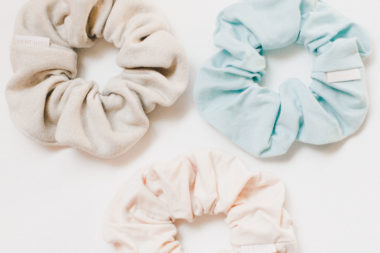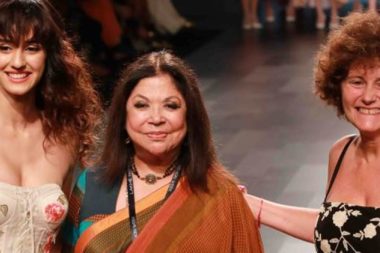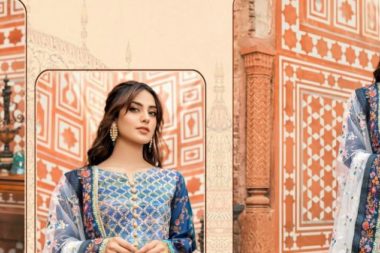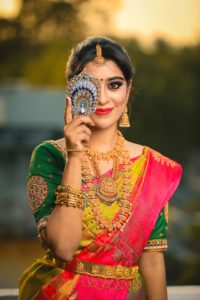 “They wrapped the newborn with a six–yard fabric and the baby emerged prudent, wise and enlightened.” Such is the beauty of Saree, the most famous dress of India. It not only clothes but also educates and it does so in a very unique manner by carrying the weaves of the rich culture, the glorious heritage and the moralistic folklore on the surface of its fabric. Major credits go to the ancient handloom industry and the unparalleled craftsmanship of the handloom artists who weave these stories on the Sarees with the help of silk and cotton threads in the form of prints, patterns, motifs and designs. Unheard pieces of history, rare tales of remote regions, intriguing ancient anecdotes, myths, legends and much more are crocheted on to the bodies and borders of the hand-woven Sarees, the glory of Indian handloom.
“They wrapped the newborn with a six–yard fabric and the baby emerged prudent, wise and enlightened.” Such is the beauty of Saree, the most famous dress of India. It not only clothes but also educates and it does so in a very unique manner by carrying the weaves of the rich culture, the glorious heritage and the moralistic folklore on the surface of its fabric. Major credits go to the ancient handloom industry and the unparalleled craftsmanship of the handloom artists who weave these stories on the Sarees with the help of silk and cotton threads in the form of prints, patterns, motifs and designs. Unheard pieces of history, rare tales of remote regions, intriguing ancient anecdotes, myths, legends and much more are crocheted on to the bodies and borders of the hand-woven Sarees, the glory of Indian handloom.
This distinctive and uncommon way of immortalizing a rich and diverse past by conserving it in the layers of a Saree has been the most fascinating dimension of 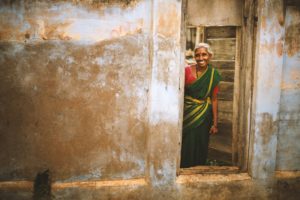 Indian handloom industry, apart from the procedures used, designs made and finesse brought out by it. This trend of immortalizing the stories of a dynamic culture makes the handloom Sarees timeless pieces of textile art. They are hugely popular across the globe and have an aggressive demand in all parts of the world. “I not only wear a mere Saree, but also a story along with it which makes the feel of the dress and the drape so satisfying”, says Kadambari, a Swedish lady at the ISKCON of Puri(a city in Eastern India).
Indian handloom industry, apart from the procedures used, designs made and finesse brought out by it. This trend of immortalizing the stories of a dynamic culture makes the handloom Sarees timeless pieces of textile art. They are hugely popular across the globe and have an aggressive demand in all parts of the world. “I not only wear a mere Saree, but also a story along with it which makes the feel of the dress and the drape so satisfying”, says Kadambari, a Swedish lady at the ISKCON of Puri(a city in Eastern India).
This article lends a look into five different types of Indian handloom Sarees that beautifully capture fragments of the diverse and amusing heritage of India in the form of fascinating weaves.
Baluchari Sarees
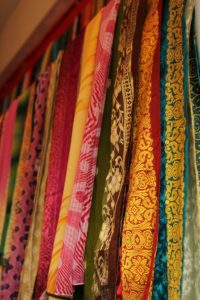 Baluchari Saree is the riveting product of a puny village named Baluchar of West Bengal. It is known for its fine craftsmanship, the use of purest of silk threads, the involvement of eco-friendly procedures like the use of leaves, fruits and flowers for organic colours and most importantly for tapping the queer mythological stories and characters from legendary epics. For instance, a royal Baluchari would vividly depict episodes from Bhagwad Gita where Krishna, the eternal symbol of truth disseminates the knowledge of enlightenment and shows the path of redemption to Arjuna, the representative of the curious humankind.
Baluchari Saree is the riveting product of a puny village named Baluchar of West Bengal. It is known for its fine craftsmanship, the use of purest of silk threads, the involvement of eco-friendly procedures like the use of leaves, fruits and flowers for organic colours and most importantly for tapping the queer mythological stories and characters from legendary epics. For instance, a royal Baluchari would vividly depict episodes from Bhagwad Gita where Krishna, the eternal symbol of truth disseminates the knowledge of enlightenment and shows the path of redemption to Arjuna, the representative of the curious humankind.
Baluchari Saree is hence an eternal piece of art and a prized possession because it not only immortalizes the glorious philosophies of a great past but also speaks to the posterity about the rich tradition that they are an offshoot of.
Swarnachari Sarees
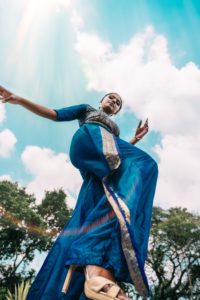 Swarnachari Sarees, also hail from West Bengal and are a richer variety of the Balucharis. Since they originated during the reign of Nawab Mushidqali Khan, they are usually associated with the elites and the aristocrats. Famous for the intricate craftsmanship, it involves ancient weaving methods, expert skillsets and vivid pictorial illustration of the exotic archaic culture.
Swarnachari Sarees, also hail from West Bengal and are a richer variety of the Balucharis. Since they originated during the reign of Nawab Mushidqali Khan, they are usually associated with the elites and the aristocrats. Famous for the intricate craftsmanship, it involves ancient weaving methods, expert skillsets and vivid pictorial illustration of the exotic archaic culture.
The elaborate Indian festivals with all their glory and grandeur, the ostentatious Indian weddings along with the sophisticated traditions associated with them, the rich flora and fauna and much more are woven as motifs and patterns into the Sarees. Some custom made Swarnachari Sarees provide a detailed evocative description and account of the mythological stories in the Aanchal, the edge of the Saree. Such designer handloom pieces, usually woven with expensive silken threads called “Zari” are prized possessions of brides and saree enthusiasts. Such belongings hold a strand of our roots that always keep reminding us about our glorious past. Sometimes such Sarees belong to the family heirloom and it is a tradition to pass on these lavish extravagant raiments to the children and the new generation with a strong desire to keep the legends alive till eternity.
Chanderi Sarees
 Chanderi Sarees, the pride of Madhya Pradesh, were initially weaved by migrated Muslim artisans from Dhaka and they witnessed the most flourishing period during the Mughal era. They are popular for their fine velvety texture called “muslin” and their incredible lightweight feel. A popular legend about Chanderi fabrics’ finesse say that one Chanderi saree could be squeezed into a narrow bamboo hole and then unfolded to cover a giant elephant.
Chanderi Sarees, the pride of Madhya Pradesh, were initially weaved by migrated Muslim artisans from Dhaka and they witnessed the most flourishing period during the Mughal era. They are popular for their fine velvety texture called “muslin” and their incredible lightweight feel. A popular legend about Chanderi fabrics’ finesse say that one Chanderi saree could be squeezed into a narrow bamboo hole and then unfolded to cover a giant elephant.
Since Chanderi Sarees have a remarkable Mughal influence, the designs and patterns on the fabric are predominantly inspired by the Muslim culture and talk profusely about the royalty of the erstwhile Mughal period. They are primarily dominated by motifs of traditional gold coins that belonged to the courts of the Mughal. These Sarees also bear the feathery peacocks, the complex detailed labyrinth of interlacing geometric designs found in Mughal architecture, stylized versions of flowers and floral arts in the forms of “butas” and motifs. They most definitely encapsulate the richness of the olden times.
Kalamkari Sarees
 Kalamkari which literally means paintings with a pen, is an art form that belongs to Andhra Pradash. It came into existence with the act of storytelling amongst the nomads while travelling from one village to another. Gradually it became a tradition to incorporate these fascinating stories about the contemporary village life, the wild flowers, the wild animals, the tribal society into the weaves of the Sarees and other garments like Dhotis, Kurtas, Dupattas, Blouses, Lehengas, Skirts, etc.
Kalamkari which literally means paintings with a pen, is an art form that belongs to Andhra Pradash. It came into existence with the act of storytelling amongst the nomads while travelling from one village to another. Gradually it became a tradition to incorporate these fascinating stories about the contemporary village life, the wild flowers, the wild animals, the tribal society into the weaves of the Sarees and other garments like Dhotis, Kurtas, Dupattas, Blouses, Lehengas, Skirts, etc.
Kalamkari Sarees, popular for their skin-friendliness, are mostly distinctive owing to their pictorial enumeration of Indian Panchatantra fables that intend to instill moral values in children. Many times, Kalamkari Sarees delineate excerpts of stories from legendary epics like Ramayana and Mahabharata.
 Similarly Pure Silk/ Raw Silk/ Tussar Silk Sarees with Pattachitra paintings on them are equally fascinating. Pattachitra, which is one of the most ancient and popular artforms of Odisha, is famous worldwide for the vivid sketch work of the traditional tribal life and folktales. The organic colours used in the paintings make them even more modern, attractive, enriching and valuable. Such assortment of stories painted on to Kalamkari and Pattachitra Sarees make them an all-time favourite amongst Western tourists in India and the connoisseurs of great works of art. These Sarees are considered timeless possessions and are sold at extremely exorbitant prices to the tourist populace in India. It is observed that the foreigners relish the charm and sophistication of these Sarees to no bounds. Western vacationists and excursionists go to the exfent of customizing canvases and picture frames with pieces of fabric bearing vintage Kalamkari artwork or Pattachitra paintings with an aim to uplift the ambience of their studios/ office spaces.
Similarly Pure Silk/ Raw Silk/ Tussar Silk Sarees with Pattachitra paintings on them are equally fascinating. Pattachitra, which is one of the most ancient and popular artforms of Odisha, is famous worldwide for the vivid sketch work of the traditional tribal life and folktales. The organic colours used in the paintings make them even more modern, attractive, enriching and valuable. Such assortment of stories painted on to Kalamkari and Pattachitra Sarees make them an all-time favourite amongst Western tourists in India and the connoisseurs of great works of art. These Sarees are considered timeless possessions and are sold at extremely exorbitant prices to the tourist populace in India. It is observed that the foreigners relish the charm and sophistication of these Sarees to no bounds. Western vacationists and excursionists go to the exfent of customizing canvases and picture frames with pieces of fabric bearing vintage Kalamkari artwork or Pattachitra paintings with an aim to uplift the ambience of their studios/ office spaces.
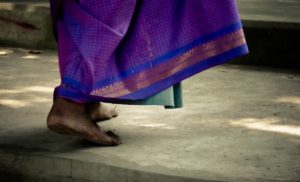 Stories and narratives weaved on the Saree keep them immune from aging or fraying. They make them resplendent and elevate their elegance by leaps and bounds. Sarees no longer remain a mere piece of clothing used to drape the body. Rather they become invaluable possessions that keep the society stitched together on a palette of nostalgia. Next time you are in India, don’t forget to pay a visit to the local Saree stores nearby just to get amazed by the beauty of a Speaking Saree.
Stories and narratives weaved on the Saree keep them immune from aging or fraying. They make them resplendent and elevate their elegance by leaps and bounds. Sarees no longer remain a mere piece of clothing used to drape the body. Rather they become invaluable possessions that keep the society stitched together on a palette of nostalgia. Next time you are in India, don’t forget to pay a visit to the local Saree stores nearby just to get amazed by the beauty of a Speaking Saree.



